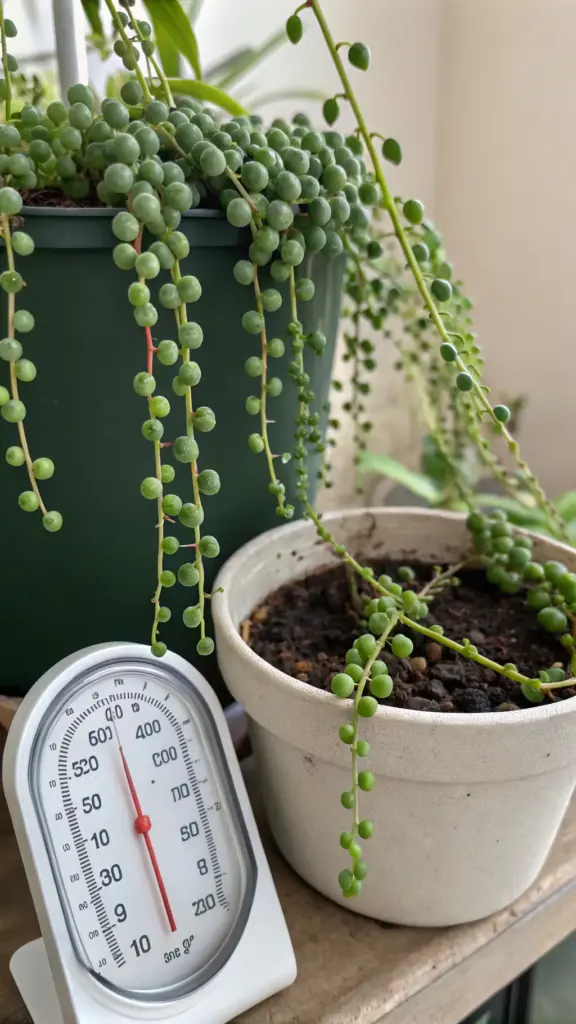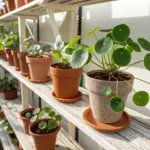4. The Humidity Hack Using Everyday Household Items

My String of Pearls was doing everything right – perfect watering, great light, regular rotation – but the pearls still looked… meh. Kind of dull and wrinkled, like tiny deflated balloons.
Turns out I was completely ignoring humidity, and these plants are way pickier about it than I realized. Who knew that desert plants still need some moisture in the air?
Why String of Pearls Demands Specific Humidity Levels
Here’s the thing that blew my mind: String of Pearls needs 40-50% humidity to really thrive. Most of our homes sit around 30-35%, especially during winter when heaters are cranking.
I discovered this when I got a cheap humidity meter from Amazon. My living room was sitting at a bone-dry 28% humidity. No wonder my poor plant looked stressed!
Those little pearl windows actually help the plant absorb moisture from the air. When humidity is too low, the pearls start to shrivel and lose that plump, glossy look.
Low humidity also makes the plant more susceptible to pests like spider mites. I learned this the hard way when my dry plant got completely infested last winter.
The plant basically goes into survival mode when humidity drops too low, focusing energy on just staying alive instead of growing those gorgeous trailing strands.
DIY Solutions Using Stuff You Already Have
I’m not about to drop $100 on a fancy humidifier for one plant. So I got creative with household items, and honestly, some of these work better than expensive gadgets.
Shallow dishes filled with water placed around the plant work surprisingly well. I use old takeout containers – classy, right?
My favorite hack is the wet towel method. I hang a damp kitchen towel near my plant (not touching it) and it slowly releases moisture as it dries.
Mason jars filled with water and placed strategically around the plant create little humidity pockets. Plus they look way better than random dishes everywhere.
Even a spray bottle with distilled water works if you mist the air around the plant (never directly on the pearls). I do this every few days during dry spells.
The Pebble Tray Method – But Make It Modern
Everyone talks about pebble trays, but the traditional method is honestly kind of ugly. I wanted something that didn’t look like a science experiment in my living room.
My upgraded version: I use a shallow ceramic tray (got it at Target for $8) filled with decorative river rocks and water. It looks intentional, not like plant care equipment.
The key is keeping the water level just below the top of the rocks. You want evaporation, not a mini swimming pool that breeds mosquitoes.
I refresh the water every 4-5 days and give the rocks a quick rinse weekly to prevent algae buildup. Takes maybe 2 minutes of maintenance.
Pro tip: Add a few drops of hydrogen peroxide to the water to keep it fresh longer. This prevents that gross stagnant smell that can develop.
The tray sits right under my plant stand, so the rising moisture creates a perfect little humidity bubble around my String of Pearls.
Strategic Plant Grouping for Natural Humidity Zones
This was a total game-changer that cost me absolutely nothing. I just rearranged my existing plants to create natural humidity microclimates.
Plants naturally release moisture through transpiration – basically plant breathing. Group them together and you get a mini rainforest effect.
I moved my String of Pearls next to my pothos and snake plant. Within two weeks, I could literally feel the difference in air moisture around that corner.
The trick is mixing different types of plants that release varying amounts of moisture. My humidity-loving plants all hang out together now like a little plant gang.
I keep a small humidity meter in this area, and it consistently reads 8-10% higher than the rest of my apartment. Free humidity boost just from strategic placement!
Seasonal Adjustments for Different Climates
Living through brutal Midwest winters taught me that seasonal humidity management is crucial. What works in July definitely doesn’t work in January.
Winter adjustments: I double up on humidity methods when the heat kicks on. Extra water dishes, more frequent misting, and I even put a pot of water on my radiator.
Summer in humid climates is the opposite problem – too much moisture can cause fungal issues. I dial back the humidity aids and focus on air circulation instead.
Geographic reality check: My friends in Arizona need year-round humidity boosts, while my Seattle buddies barely need any help during their rainy season.
I track my local weather and adjust accordingly. Dry spell coming? Time to break out all the humidity tricks. Rainy week ahead? I back off and let nature do the work.
The visual difference is incredible when you get humidity right. Those pearls become plump and glossy, almost like they’re glowing from within.
Plus, proper humidity makes the plant way more resilient to other stressors. It’s like giving your String of Pearls a suit of armor against environmental challenges.
Ready to nail the final piece of the String of Pearls puzzle? Click “next” to discover the fertilization formula that prevents nutrient burn – because even I managed to nearly kill my thriving plant with the wrong feeding schedule!









GIPHY App Key not set. Please check settings